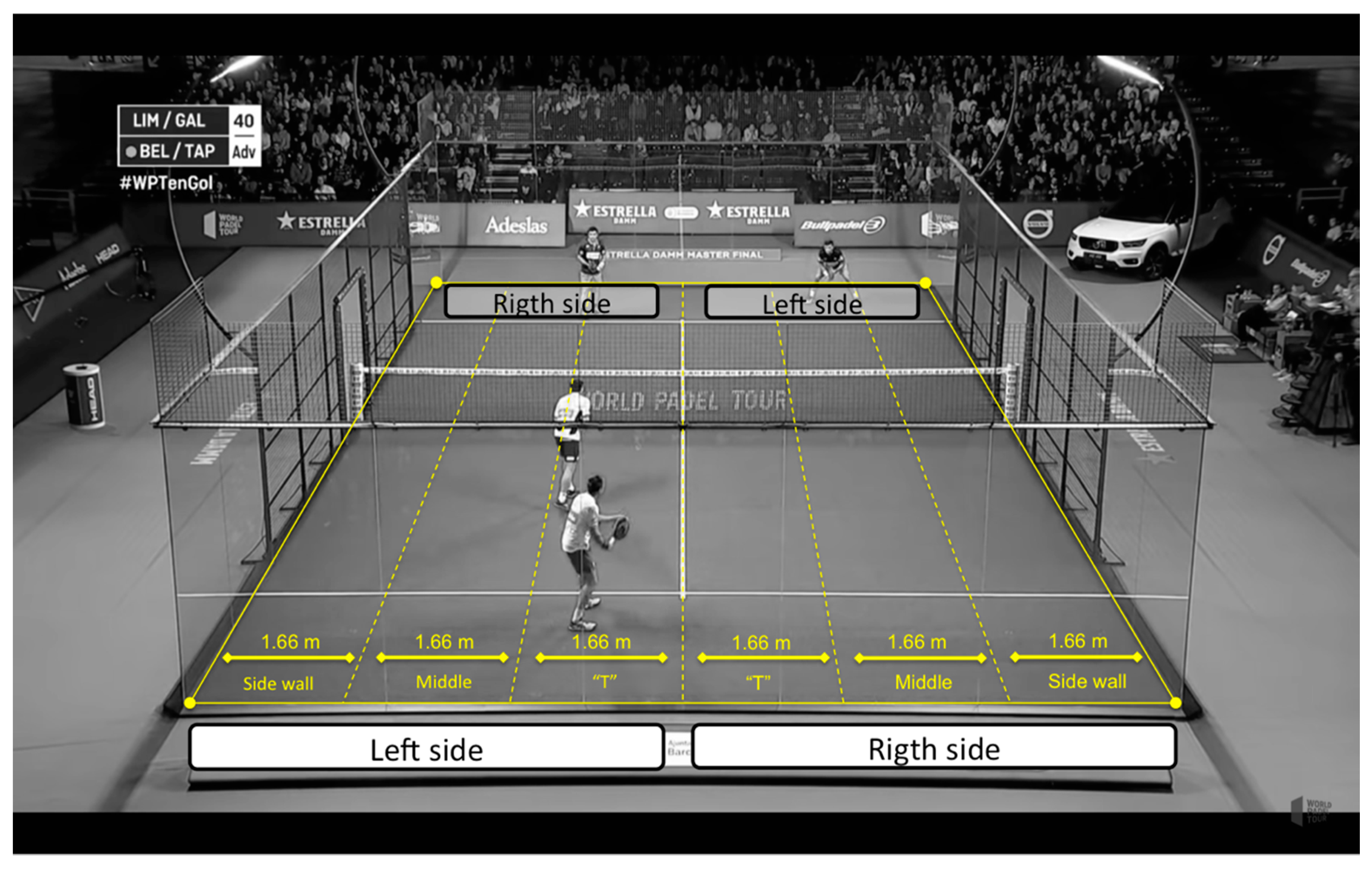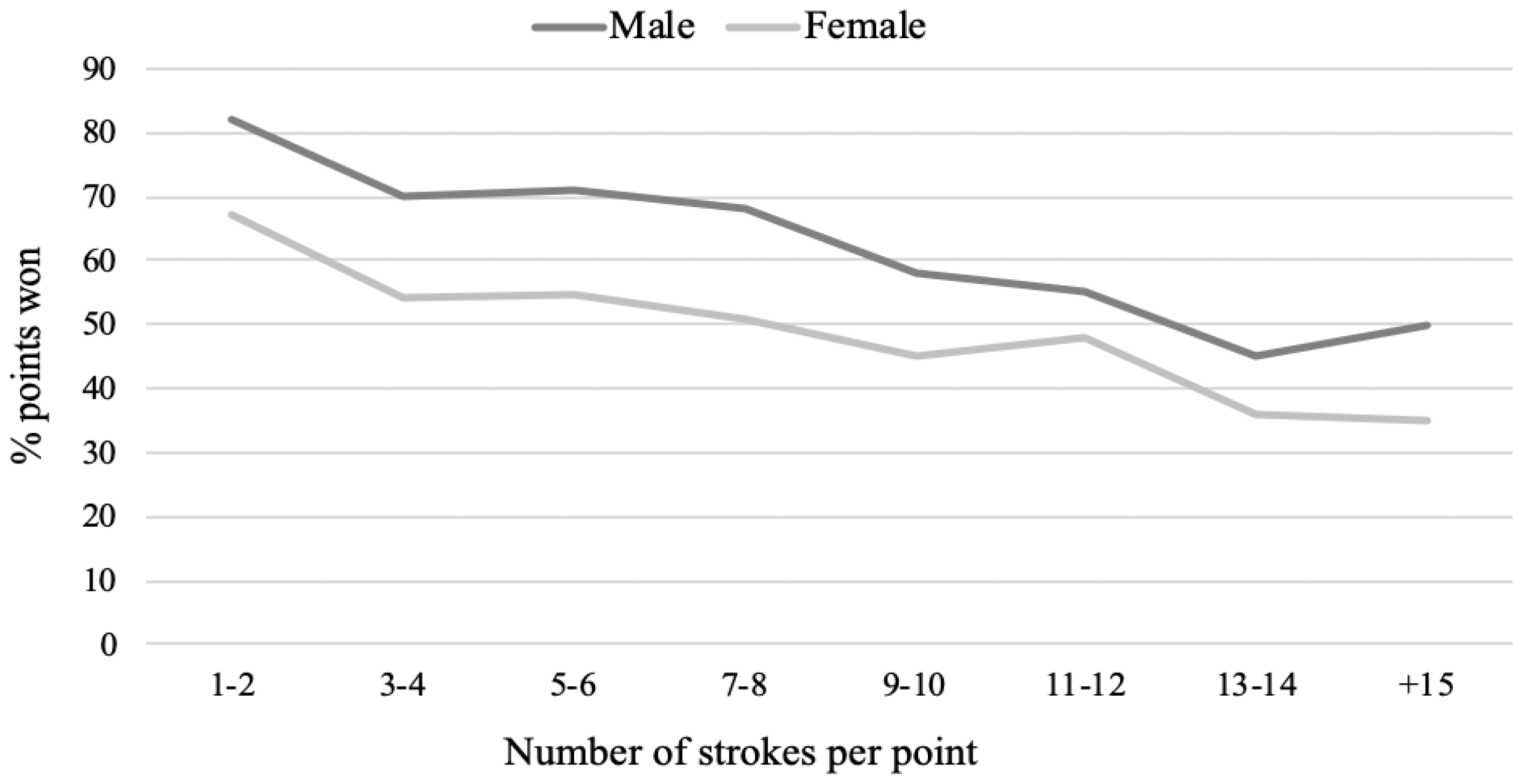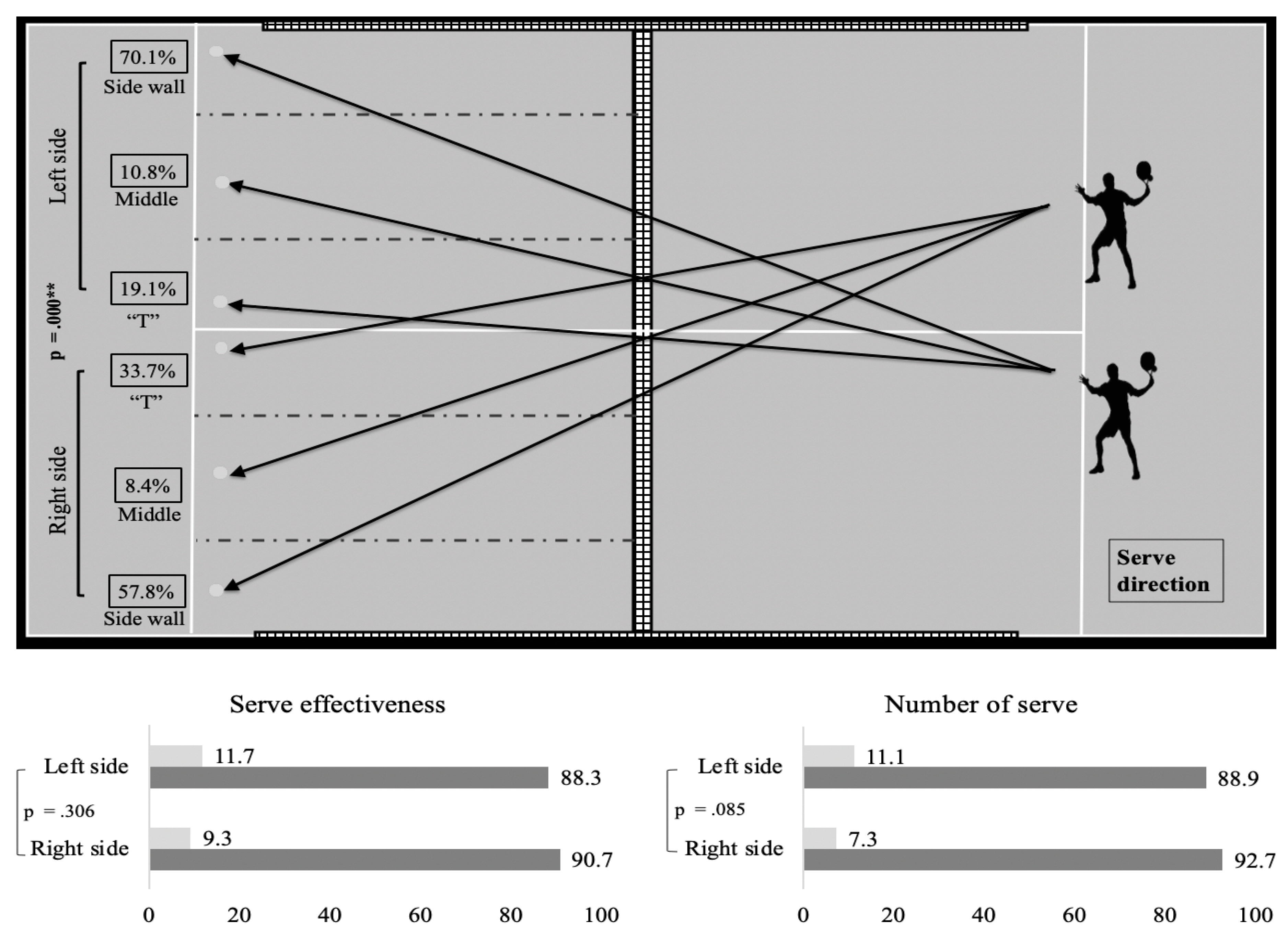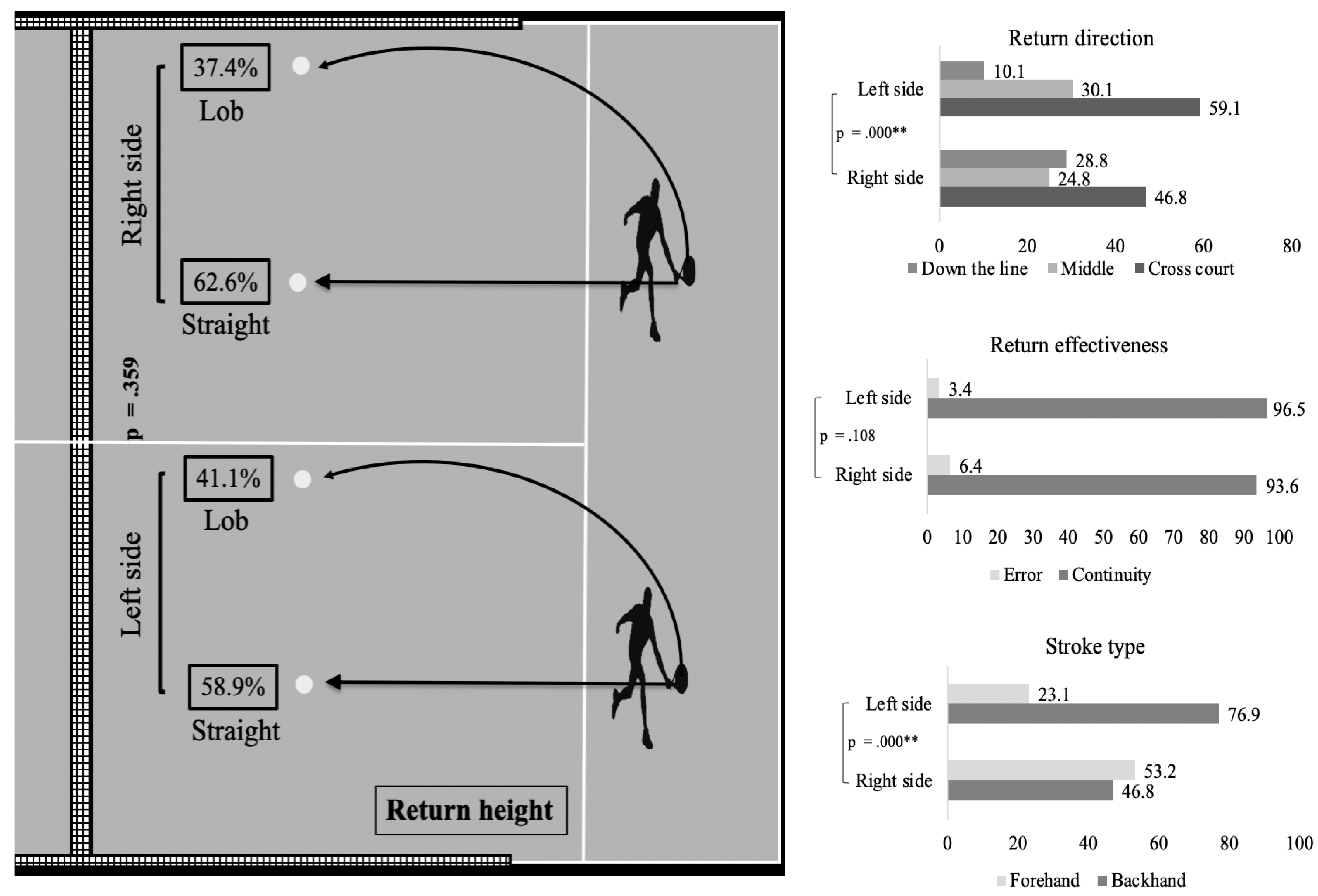Analysis of Serve and Serve-Return Strategies in Elite Male and Female Padel
Abstract
1. Introduction
2. Materials and Methods
2.1. Sample and Variables
- Serve shots were analyzed regarding the serve number (1st and 2nd serve), court side (right and left), serve direction (side wall, middle and T) and effectiveness indicator (winner, error and continuity) (Figure 1).
- Return statistics were analyzed regarding the court side (right and left), stroke direction (down the line, middle and cross court), stroke height (straight and lob), stroke type (forehand and backhand) and effectiveness indicator (winner, error and continuity) (Figure 1).
- Point outcome: strokes were classified according to the winning or losing pair of the point (serving players win and returning players win).
- Total shots: number of total shots in the points were counted.
2.2. Procedure
2.3. Data Analysis
3. Results
3.1. Serve and Return Performances of Professional Padel Players Regarding Gender
3.2. Serve and Return Performances of Professional Padel Players Regarding Court Side
4. Discussion
5. Conclusions
Author Contributions
Funding
Conflicts of Interest
References
- International Padel Federation. Rules of Padel. FIP, V.D. Available online: https://www.padelfip.com/wp-content/uploads/2017/06/Rules-of-Padel.pdf (accessed on 1 July 2020).
- Courel-Ibáñez, J.; Sánchez-Alcaraz, B.J.; García, S.; Echegaray, M. Evolution of padel in spain according to practitioners’ gender and age [Evolución del pádel en España en función del género y edad de los practicantes]. Cult. Cienc. Deporte 2017, 12, 39–46. [Google Scholar] [CrossRef]
- Carrasco, L.; Romero, S.; Sañudo, B.; de Hoyo, M. Game analysis and energy requirements of paddle tennis competition. Sci. Sports 2011, 26, 338–344. [Google Scholar] [CrossRef]
- Courel-Ibáñez, J.; Sánchez-Alcaraz, B.J.; Cañas, J. Game performance and length of rally in professional padel players. J. Hum. Kinet. 2017, 55, 161–169. [Google Scholar] [CrossRef]
- Castillo-Rodríguez, A.; Alvero-Cruz, J.R.; Hernández-Mendo, A.; Fernández-García, J.C. Physical and physiological responses in paddle tennis competition. Int. J. Perform. Anal. Sport 2014, 14, 524–534. [Google Scholar] [CrossRef]
- Duda, J.L. Motivation in Sport: The relevance of competence and achievement goals. In Handbook of Competence and Motivation; Elliot, A., Dweck, C., Eds.; Guildford Publications: New York, NY, USA, 2005; pp. 311–330. [Google Scholar]
- Courel-Ibáñez, J.; Sánchez-Alcaraz, B.J.; Muñoz, D.; Grijota, F.J.; Chaparro, R.; Díaz, J. Gender reasons for practicing paddle tennis [Motivos de género para la práctica de pádel]. Apunt. Educ. Fis. y Deportes. 2018, 133, 116–125. [Google Scholar] [CrossRef]
- Sánchez-Alcaraz, B.J.; Courel-Ibáñez, J.; Cañas, J. Temporal structure, court movements and game actions in padel: A systematic review [Estructura temporal, movimientos en pista y acciones de juego en pádel: Revisión sistemática]. Retos, Nuevas Tend. Deport Educ. Física Recreación 2018, 33, 221–225. [Google Scholar]
- Courel-Ibáñez, J.; Sánchez-Alcaraz, B.J.; Cañas, J. Effectiveness at the net as a predictor of final match outcome in professional padel players. Int. J. Perform. Anal. Sport 2015, 15, 632–640. [Google Scholar] [CrossRef]
- Torres-Luque, G.; Ramirez, A.; Cabello-Manrique, D.; Nikolaidis, P.T.; Alvero-Cruz, J.R. Match analysis of elite players during paddle tennis competition. Int. J. Perform. Anal. Sport 2015, 15, 1135–1144. [Google Scholar] [CrossRef]
- Courel-Ibáñez, J.; Sánchez-Alcaraz, B.J.; Muñoz, D. Exploring game dynamics in padel: Implications for assessment and training. J. Strength Cond. Res. 2019, 33, 1971–1977. [Google Scholar] [CrossRef]
- Courel-Ibáñez, J.; Sánchez-Alcaraz, B.J. The role of hand dominance in padel: Performance profiles of professional players. Motricidade 2018, 14, 33–41. [Google Scholar] [CrossRef]
- García-Benítez, S.; Pérez-Bilbao, T.; Echegaray, M.; Felipe, J.L. The influence of gender on temporal structure and match activity patterns of professional padel tournaments. Cult. Cienc. Deport 2016, 33, 241–247. [Google Scholar] [CrossRef]
- Sánchez-Alcaraz, B.J. Game actions and temporal structure diferences between male and female professional paddle players [Diferencias en las acciones de juego y la estructura temporal entre el pádel masculino y femenino profesional]. Acción Mot. 2014, 12, 17–22. [Google Scholar]
- Lupo, C.; Condello, G.; Courel-Ibáñez, J.; Gallo, C.; Conte, D.; Tessitore, A. Effect of gender and match outcome on professional padel competition. RICYDE Rev. Int. Cienc. Deport 2018, 51, 29–41. [Google Scholar] [CrossRef]
- Ramón-Llin, J.; Guzmán, J.F.; Llana, S.; Martínez-Gallego, R.; James, N.; Vučković, G. The effect of the return of serve on the server pair’s movement parameters and rally outcome in padel using cluster analysis. Front. Psychol. 2019, 10, 1–8. [Google Scholar] [CrossRef] [PubMed]
- Gillet, E.; Leroy, D.; Thouvarecq, R.; Stein, J.F. A notational analysis of elite tennis serve and serve-return strategies on slow surface. J. Strength Cond. Res. 2009, 23, 532–539. [Google Scholar] [CrossRef]
- Reid, M.; McMurtrie, D.; Crespo, M. The relationship between match statistics and top 100 ranking in professional men’s tennis. Int. J. Perform. Anal. Sport 2010, 10, 131–138. [Google Scholar] [CrossRef]
- O’Donoghue, P. The most important points in grand slam singles tennis. Res. Q. Exerc. Sport 2001, 72, 125–131. [Google Scholar] [CrossRef]
- Furlong, J. The service in lawn tennis: How important is it? In Science and Racket Sports I; Reilly, T., Hughes, M.D., Lees, A., Eds.; E &FN Spon: London, UK, 1995. [Google Scholar]
- McGarry, T. Applied and theoretical perspectives of performance analysis in sport: Scientific issues and challenges. Int. J. Perform. Anal. Sport 2009, 9, 128–140. [Google Scholar] [CrossRef]
- O’Donoghue, P.; Brown, E. The importance of service in Grand Slam singles tennis. Int. J. Perform. Anal. Sport 2008, 8, 70–78. [Google Scholar] [CrossRef]
- Zhang, H.; Zhou, Z. An analytical model of the two basic situation strategies in table tennis. Int. J. Perform. Anal. Sport 2017, 17, 970–985. [Google Scholar] [CrossRef]
- Vernon, G.; Farrow, D.; Reid, M. Returning serve in Tennis: A qualitative examination of the interaction of anticipatory information sources used by professional tennis players. Front. Psychol. 2018, 9, 1–11. [Google Scholar] [CrossRef] [PubMed]
- Hizan, H.; Whipp, P.; Reid, M. Gender differences in the spatial distributions of the tennis serve. Int. J. Sport Sci. Coach. 2015, 10, 87–96. [Google Scholar] [CrossRef]
- World Padel Tour Youtube Chanel. Available online: https://www.youtube.com/user/WorldPadelTourAJPP (accessed on 1 February 2020).
- Gabin, B.; Camerino, O.; Anguera, M.T.; Castañer, M. Lince: Multiplatform sport analysis software. Procedia-Soc. Behav. Sci. 2012, 46, 4692–4694. [Google Scholar] [CrossRef]
- Kinovea Sofware (V.08.26,). Available online: https://www.kinovea.org. (accessed on 1 February 2020).
- Randolph, J.J. Free-Marginal Multirater Kappa: An Alternative to Fleiss’ Fixed-Marginal Multirater Kappa; Joensuu University Learning and Instruction Symposium: Joensuu, Finlandia, 2005. [Google Scholar]
- Robinson, G.; O’Donoghue, P.G. A weighted kappa statistic for reliability testing in performance analysis of sport. Int. J. Perform. Anal. Sport 2007, 7, 12–19. [Google Scholar] [CrossRef]
- Altman, D.G. Practical Statistics for Medical Research; Chapman and Hall: London, UK, 1991. [Google Scholar]
- Pallant, J. SPSS Survival Manual: A Step by Step Guide to Data Analysis Using SPSS Program; Alen & Unwin: Crows Nest, Australia, 2011. [Google Scholar]
- Cohen, J. Statistical Power Analysis for the Behavioural Science (2nd Edition). In Statistical Power Anaylsis for the Behavioral Sciences; Lawrence Erlbaum: Hillsdale, NJ, USA, 1988. [Google Scholar]
- Reid, M.; Morgan, S.; Whiteside, D. Matchplay characteristics of Grand Slam tennis: Implications for training and conditioning. J. Sport Sci. 2016, 34, 1791–1798. [Google Scholar] [CrossRef]
- Sim, M.K.; Choi, D.G. The winning probability of a game and the importance of points in tennis matches. Res. Q. Exerc. Sport 2020, 91, 361–372. [Google Scholar] [CrossRef]
- Sánchez-Muñoz, C.; Muros, J.J.; Cañas, J.; Courel-Ibáñez, J.; Sánchez-Alcaraz, B.J.; Zabala, M. Anthropometric and physical fitness profiles of world-class male padel players. Int. J. Environ. Res. Public Health 2020, 17, 508. [Google Scholar] [CrossRef]
- Castillo-Rodríguez, A.; Hernández-Mendo, A.; Alvero-Cruz, J.R. Morphology of the elite paddle player—Comparison with other racket sports. Int. J. Morphol. 2014, 32, 177–182. [Google Scholar] [CrossRef][Green Version]
- Fitzpatrick, A.; Stone, J.A.; Choppin, S.; Kelley, J. A simple new method for identifying performance characteristics associated with success in elite tennis. Int. J. Sport Sci. Coach. 2019, 14, 43–50. [Google Scholar] [CrossRef]
- Ramón-Llin, J.; Guzmán, J.F.; Belloch, S.L.; Vučković, G.; James, N. Comparison of distance covered in paddle in the serve team according to performance level. J. Hum. Sport Exerc. 2013, 8, 738–742. [Google Scholar] [CrossRef]
- Escudero-Tena, A.; Fernández-Cortes, J.; García-Rubio, J.; Ibáñez, S.J. Use and efficacy of the lob to achieve the offensive position in women’s professional padel. Analysis of the 2018 WPT finals. Int. J. Environ. Res. Public Health 2020, 17, 4061. [Google Scholar] [CrossRef]
- Unierzyski, P.; Wieczorek, A. Comparison of tactical solutions and game patterns in the finals of two grand slam tournaments in tennis. In Science and Racket Sports III; Kahn, J., Lees, A., Maynard, I., Eds.; Routledge: London, UK, 2004; pp. 169–174. [Google Scholar]
- Cui, Y.; Gómez, M.Á.; Gonçalves, B.; Sampaio, J. Performance profiles of professional female tennis players in grand slams. PLoS ONE 2018, 13, e0200591. [Google Scholar] [CrossRef]
- O’Donoghue, P.; Ballantyne, A. The impact of speed of service in Grand Slam singles tennis. In Science and Racket Sports III; Lees, A., Kahn, J., Maynard, I., Eds.; Routledge: London, UK, 2008; pp. 179–184. [Google Scholar]
- García-Benítez, S.; Courel-Ibáñez, J.; Pérez-Bilbao, T.; Felipe, J.L. Game responses during young padel match play: Age and sex comparisons. J. Strength Cond. Res. 2018, 32, 1144–1149. [Google Scholar] [CrossRef] [PubMed]
- Muñoz, D.; Courel-Ibáñez, J.; Sánchez-Alcaraz, B.J.; Díaz, J.; Grijota, F.J.; Munoz, J. Analysis of the use and effectiveness of lobs to recover the net in the context of padel [Análisis del uso y eficacia del globo para recuperar la red en función del contexto de juego en pádel]. Retos Nuevas Tend. Deport Educ. Física Recreación 2017, 31, 19–22. [Google Scholar]
- Priego, J.I.; Olaso, J.; Llana, S.; Pérez, P.; Gonález, J.C.; Sanchís, M. Padel: A quantitative study of the shots and movements in the high-performance. J. Hum. Sport Exerc. 2013, 8, 925–931. [Google Scholar] [CrossRef]
- Martínez-Gallego, R.; Guzmán Luján, J.F.; James, N.; Pers, J.; Ramón-Llin, J.; Vučković, G. Movement characteristics of elite tennis players on hard courts with respect to the direction of ground strokes. J. Sport Sci. Med. 2013, 12, 275–281. [Google Scholar]
- Gómez, M.Á.; Lago-Peñas, C.; Pollard, G. Situational variables. In Routledge Handbook of Sports Performance Analysis; McGarry, T., O’Donoghue, P., Sampaio, J., Eds.; Routledge: London, UK, 2003; pp. 259–269. [Google Scholar]




| Male n (%) | Female n (%) | Sig. | ||
|---|---|---|---|---|
| Serve statistics | ||||
| Serve Number | ||||
| 1st serve | 378 (92.9)a | 229 (87.7)b | 0.025 * | |
| 2nd serve | 29 (7.1)a | 32 (12.3)b | ||
| Court side | ||||
| Right | 211 (51.8) | 133 (51.0) | 0.823 | |
| Left | 196 (48.2) | 128 (49.0) | ||
| Serve direction | ||||
| Side wall | 263 (64.6) | 163 (62.5) | 0.101 | |
| Middle | 45 (11.1) | 19 (7.3) | ||
| T | 99 (24.3) | 79 (30.3) | ||
| Effectiveness | ||||
| Winner | 0 (0.0) | 0 (0.00) | 0.085 | |
| Error | 36 (8.8) | 34 (13.0) | ||
| Continuity | 371 (91.2) | 227 (87.0) | ||
| Return statistics | ||||
| Stroke direction | ||||
| Down the line | 213 (57.4)a | 103 (45.0)b | 0.008 ** | |
| Middle | 95 (25.6) | 69 (30.1) | ||
| Cross court | 63 (17.0)a | 57 (24.9)b | ||
| Stroke height | ||||
| Straight | 242 (65.2)a | 122 (53.3)b | 0.009 ** | |
| Lob | 129 (34.7)a | 107 (46.7)b | ||
| Stroke type | ||||
| Forehand | 156 (42.0)a | 77 (33.6)b | 0.040 * | |
| Backhand | 215 (58.0)a | 152 (64.4)b | ||
| Effectiveness | ||||
| Winner | 0 (0.0) | 1 (0.4) | 0.323 | |
| Error | 20 (5.4) | 9 (3.9) | ||
| Continuity | 351 (94.96) | 219 (95.6) | ||
| Point outcome | ||||
| Serve pair win | 232 (62.5)a | 111 (48.5)b | 0.001 ** | |
| Returner pair win | 139 (37.5)a | 118 (51.5)b | ||
© 2020 by the authors. Licensee MDPI, Basel, Switzerland. This article is an open access article distributed under the terms and conditions of the Creative Commons Attribution (CC BY) license (http://creativecommons.org/licenses/by/4.0/).
Share and Cite
Sánchez-Alcaraz, B.J.; Muñoz, D.; Pradas, F.; Ramón-Llin, J.; Cañas, J.; Sánchez-Pay, A. Analysis of Serve and Serve-Return Strategies in Elite Male and Female Padel. Appl. Sci. 2020, 10, 6693. https://doi.org/10.3390/app10196693
Sánchez-Alcaraz BJ, Muñoz D, Pradas F, Ramón-Llin J, Cañas J, Sánchez-Pay A. Analysis of Serve and Serve-Return Strategies in Elite Male and Female Padel. Applied Sciences. 2020; 10(19):6693. https://doi.org/10.3390/app10196693
Chicago/Turabian StyleSánchez-Alcaraz, Bernardino J, Diego Muñoz, Francisco Pradas, Jesús Ramón-Llin, Jerónimo Cañas, and Alejandro Sánchez-Pay. 2020. "Analysis of Serve and Serve-Return Strategies in Elite Male and Female Padel" Applied Sciences 10, no. 19: 6693. https://doi.org/10.3390/app10196693
APA StyleSánchez-Alcaraz, B. J., Muñoz, D., Pradas, F., Ramón-Llin, J., Cañas, J., & Sánchez-Pay, A. (2020). Analysis of Serve and Serve-Return Strategies in Elite Male and Female Padel. Applied Sciences, 10(19), 6693. https://doi.org/10.3390/app10196693









